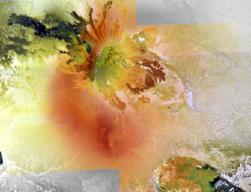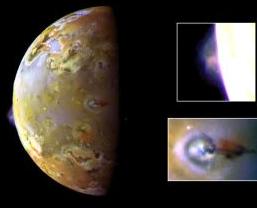Io: Jupiter's Volcanic Moon
 Why would we consider Io in our search for Life in the Universe?
Recall the importance of volcanic sub-ocean heating in providing a source
of accessible energy for early life on Earth. Io is able to offer quite a
bit of heat to a primitive life form.
Why would we consider Io in our search for Life in the Universe?
Recall the importance of volcanic sub-ocean heating in providing a source
of accessible energy for early life on Earth. Io is able to offer quite a
bit of heat to a primitive life form.
 Volcanism on Io
Volcanism on Io
Fiery volcanos pepper Io's landscape, and massive lava flows
completely resurface Io regularly over enormous distances.
Geyser-like eruptions eject dust and gas hundreds of km
into space (due in part to the low gravity), which fall back
to the ground in elegant umbrella-shaped plumes. Io has some
of the hottest temperatures in the solar system outside
of the sun, yet most of the surface is bitterly cold!
Sulfur (S) and sulfur dioxide (SO2) are found everywhere on Io, as evidenced by its surface coloration of yellow, orange, red, and black. These colors represent the palette of sulfur at varying temperatures. The patchwork of white deposits is thought to be sulfur dioxide frost which has condensed out on Io's cold surface.
 Plumes and Geysers
Plumes and Geysers
Among the most impressive sights in the solar system are the
umbrella-shaped plumes that can be seen over many of Io's
volcanic centers. Due to Io's low gravity and low atmospheric
pressure, dust and gas ejected from volcanic vents rise to
more than 400 km (250 miles).
When the plumes were first discovered, planetary scientists thought that they were explosive volcanic eruptions similar to those of Mt. St. Helens which erupted in Washington State in 1980. They have now determined that plume eruptions are more closely related to geysers on Earth. Geysers are powered by the change of super-heated water to steam as it nears Earth's surface. Since there is no water on Io, sulfur and sulfur dioxide are thought to be the fluids that power the plume eruptions.
But is there likely to be Life on Io?
Probably not. The environment is just too extreme, and
the surface appears to be completely devoid of water. Probably
Io lost its water, with all the volcanism. It is also possible
Io never had any. During Io's formation, so close to the
very hot, young Jupiter, the solid materials it could form from
may not have included solid water ice (it was in vapor form),
only rock.